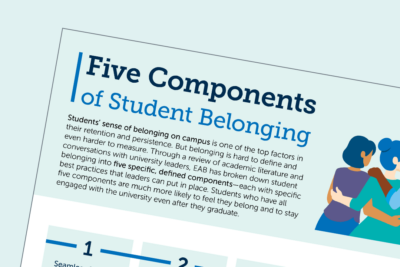How to Better Engage Faculty in Student Mental Health and Well-Being Support
This report is now free to access as part of EAB’s work to help education leaders and employers tackle student readiness challenges.
Student mental health is vital to student success, retention, and recruitment. Mental health concerns are a contributing factor to why nearly one third of students dropped out of college and student anxiety and depression are associated with lower grade point averages. At the same time, students and families are increasingly prioritizing mental health support as a major consideration when selecting an institution. 60 percent of prospective students reported that mental health services are a very important factor when selecting which institution they will attend and mental health recently topped the list of priorities for parents with college-bound children.
Given student mental health’s integral role in mission-critical goals, it became an urgent institution-wide priority. Read on for key takeaways or download the full report as a PDF.
Why student mental health is an urgent priority
Indicators point towards escalating student mental health crisis in years ahead
Across the last decade, mental health concerns among adolescents have been progressively rising. In 2021, 42 percent of high school students reported experiencing persistent feelings of sadness or hopelessness, a steady increase from 28 percent of high school students in 2011. Pandemic stress, grief, and isolation, compounded by political, social, and economic challenges, brought students’ already declining mental health to a head.
The daunting outlook of student mental health underscores the importance of having a comprehensive student mental health support strategy. This importance will only grow in the years ahead as student mental health needs will likely continue increasing in volume and complexity.
How to prepare faculty to better support student mental health
It is more urgent now than ever before for academic leaders to establish, or re-establish, a clear role for faculty in student mental health and equip them with actionable resources to appropriately scale how they engage in student support. Academic leaders have the greatest influence over how faculty engage in many roles on campus, and student support needs are no exception. Therefore, to fully integrate student mental health into faculty expectations and understanding of their role, leader intervention is required.
Luckily, there is growing interest from faculty to be adequately trained and involved in this work.
But familiarity with and desire to engage in student mental health support often varies among faculty at each institution. Academic leaders could likely identify and place their faculty on a spectrum ranging from those who are completely unengaged and uninterested in this work to those who are champions for student mental health.
Wide spectrum of baseline faculty interest and engagement in student mental health

Why Student Mental Health is an Urgent Priority
5 components to better support the faculty role
1. Setting clear expectations around the faculty role
When faculty find themselves in real-life situations with students, it is not uncommon for them to question how to respond or feel they do not have the expertise to provide support in a helpful way.
Academic leaders who clearly communicate their expectations of faculty involvement in student mental health support can help alleviate faculty uncertainty and confusion, which in turn benefits students.
2. Streamlining how faculty refer students
Faculty play a key role as members of your campus-wide referral network. But, given the number of responsibilities faculty are often juggling, knowing when and how to refer students to mental health supports may not always be top of mind.
Therefore, to ensure faculty refer students in need of extra support, academic leaders must make it easy for faculty to use the referral process.
3. Encouraging faculty to integrate well-being into the classroom
The classroom comprises the biggest opportunity for faculty to engage and impact students. Therefore, a key opportunity for faculty to influence student mental health is to design learning environments that actively support students’ well-being. Since the classroom offers an important avenue for faculty to participate in mental health, it is essential that leaders provide simple ways for faculty to engage.
4. Offering upskilling opportunities for interested faculty members
Some faculty are interested in being more involved in student mental health support, beyond knowing how to refer students to the counseling center or altering small behaviors to demonstrate support. To help faculty be successful in this endeavor, leaders can offer opportunities for faculty to deepen their expertise in student mental health, while still acting appropriately to their role. Providing additional resources and guidance to engaged faculty ensures that academic leaders leverage faculty invested in student mental health in a responsible and sustainable way.
5. Recognizing the impact of faculty champions
Finally, academic leaders are deeply influential when setting the tone around student mental health, promoting faculty participation, and recognizing those individuals who support well-being initiatives.
More Resources

Construction Kit for Faculty AI Resources

Student Experience and Well-being Resource Center
